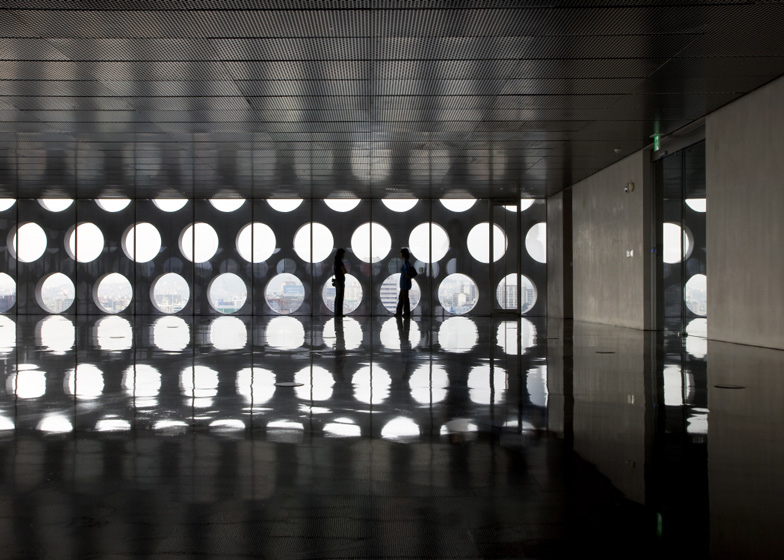Hundreds of circular apertures perforate the reinforced concrete walls of this office tower in Seoul by Korean studio Archium, designed to recreate the structural strength of honeycomb (+ slideshow).
The dotted facade of the Urban Hive building in Seoul's Gangnam district was developed by Archium as a load-bearing surface that enables the interior spaces to be largely free from supporting structures.
"Urban Hive is an example of the skin and structure unification in a building and has been designed to maximise the flexibility of the space by excluding structural elements, other than the core, in the users' space," said the architect.
A wall thickness of 400 millimetres and the regular spacing of the holes results in a robust yet flexible structure able to withstand the movement generated by earthquakes.
The homogenous pattern covers the entirety of the 17-storey box, making it difficult to discern the position of the different floors and giving the building a monolithic presence. The round holes also create a contrast with the right angles of the surrounding cityscape.
One corner of the facade is spliced away to form a void leading to an underground parking area, while a hole at the opposite corner and a triangular opening mark the main entrances.
The gaps lead to a covered area between the facade and the timber-clad core of the building, where doors open into a cafe that fills most of the ground floor. Further entrances at the side provide access to staircases and lifts to the office floors.
These office levels feature glossy floors that reflect a pattern of light and shadow created by the holes in the facade. A gap between the inner and outer curtain wall helps to shade the interiors from the sun and is widened along one side of the building to create a corridor with access to toilets and circulation facilities.
A garden on the roof is surrounded by the upper extremities of the perforated walls and incorporates a decked area with seating from which office workers and visitors can look out over the city.
The first basement level houses a retail space that can be accessed via a subway, while three further underground floors contain service areas and car parking.
Photography is by Young-chae Park.
The architects sent us the following details:
Urban Hive, Gangnam-gu, Seoul
The cube with combination of white openings which is located on corner of crossroad in Kang-nam Ave. is emptied and opened. The simplicity of monolith is a gesture to hold an atmosphere of floating city. The combination of round holes is not intended to express effectiveness of modelling but an attempt as a mechanical settlement of structural walls which is exposed to outside on double skin.
When the perspective is relaxation of city's tension with the lightness without massive concrete and the softness without rigidity, the close-range view is a various expression of detail of roundness which arouse from monotonous in city. The way that connects city and architecture is just a same process that connects architecture and humans. The lobby and entrance is not established even the open space is settled. The access of each floor is directly linked to the city's road.
In architecture, a building's structure and the skin has been treated as a separate subject. The embracement of new materials and advanced technologies has allowed the architects to design Structural Skin, which the surface of the building acts as the structure and vice versa. Urban Hive is an example of the skin and structure unification in a building; and has been designed to maximise the flexibility of the space by excluding structural elements, other than the core, in the users' space.
The coloured-exposed concrete skin structure with void circles is designed to minimise the distinction between the columns, beams and the wall. The consistent spacing of the reinforced concrete, thickness of 400mm and inner diameter of 1050mm, has been designed to replicate the honeycomb structure.
This form of structure has excellence in safety towards the dead and live loads as well as the natural disasters such as earthquakes. In addition, it adds an advantage for creating a flexible spacing. This type of skin does not only act as the structure, but also contributes in formation of a dynamic space; and the punctured circular frames provide various views.
The space between the inner and outer glass curtain wall creates a shade, which has multiple functions. From the design perspective, it creates depth in the building and makes it difficult for the viewers to differentiate the floor levels, which then allows the façade to be viewed as one piece. As for the energy saving purposes, it blocks hot direct sunlight and cold wind, and forms convection current to lower the temperature of the heated glass.










